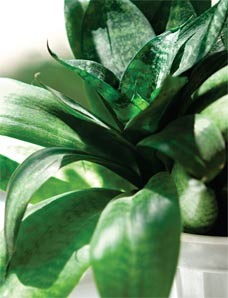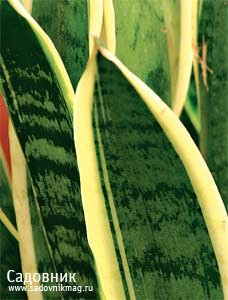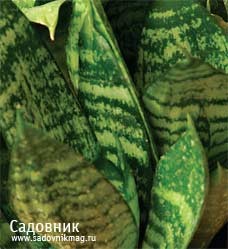 Flowers mother-in-law's tongueSansevieria belongs to the familydracaena (Dracaenaceae) and is closely related to such indoor plants as dracaena, nolina. The genus received its Latin name in honor of the Neapolitan prince von Sanseviero, who contributed to the development of natural sciences. In nature, there are about 60 species of these plants. The homeland of sansevieria is the tropical regions of Africa and Asia. In savannas, they grow in clumps among baobabs, and in sandy deserts, along river valleys, together with milkweeds, they form impenetrable thickets. Sansevieria are rhizomatous plants with a rosette of erect decorative fleshy leaves. For their shape and color, people call them "pike tail", "mother-in-law's tongue", "snake skin" and even "African hemp". Dense fleshy leaves serve as a reservoir, in which, thanks to the water-storing tissue, water is retained and the plant easily endures dry periods. Greenish-white flowers with narrow petals and long stamens, collected in a dense cylindrical inflorescence on a long erect peduncle, are very fragrant - they open in the evening and emit a strong vanilla aroma at night. The fruit of sansevieria is a spherical berry of bright red or orange color. Many sansevierias are grown in culture for the sake of valuable technical fiber obtained from the leaves, and various garden forms are successfully used for landscaping of premises and winter gardens. Care
Flowers mother-in-law's tongueSansevieria belongs to the familydracaena (Dracaenaceae) and is closely related to such indoor plants as dracaena, nolina. The genus received its Latin name in honor of the Neapolitan prince von Sanseviero, who contributed to the development of natural sciences. In nature, there are about 60 species of these plants. The homeland of sansevieria is the tropical regions of Africa and Asia. In savannas, they grow in clumps among baobabs, and in sandy deserts, along river valleys, together with milkweeds, they form impenetrable thickets. Sansevieria are rhizomatous plants with a rosette of erect decorative fleshy leaves. For their shape and color, people call them "pike tail", "mother-in-law's tongue", "snake skin" and even "African hemp". Dense fleshy leaves serve as a reservoir, in which, thanks to the water-storing tissue, water is retained and the plant easily endures dry periods. Greenish-white flowers with narrow petals and long stamens, collected in a dense cylindrical inflorescence on a long erect peduncle, are very fragrant - they open in the evening and emit a strong vanilla aroma at night. The fruit of sansevieria is a spherical berry of bright red or orange color. Many sansevierias are grown in culture for the sake of valuable technical fiber obtained from the leaves, and various garden forms are successfully used for landscaping of premises and winter gardens. Care As already mentioned, sansevieria are absolutelyunpretentious and easy to care for. In summer, these plants prefer a temperature of 20-25°C, in winter not lower than 15°C. They feel great both in sunny places and in the shade. But with a lack of light, the patterns on the leaves of varietal specimens disappear. Thanks to the wax coating on the leaves, the plant tolerates dry air indoors well, it does not need to be sprayed, but it is useful to periodically wipe the leaves with a damp cloth. Sansevieria are watered moderately, from spring to autumn - as the soil dries out, in winter - no more than twice a month. From April to August, complex fertilizers for cacti are added to the soil once a month. Sansevieria should be replanted only when the rhizomes begin to crawl out of the pot. Containers for this plant are chosen low and wide, since the thick, fleshy roots of sansevieria are located near the surface of the earth. At the bottom - drainage of broken shards, small gravel and expanded clay. Sansevieria grows better in a mixture of turf and leaf soil with the addition of sand (1:1:2). Sansevieria rarely get sick, they are not attacked by pests. But with excess moisture, the root collar can rot, the leaves will begin to fall off, and crusty spots will form on the leaf blades. Reproduction Sansevieria are propagated by dividing the rhizome or leaf cuttings. Division is carried out in early spring or autumn, while old specimens are washed from the soil, dividing the rhizome into several parts so that each has 2-3 leaves. The cuts are powdered with crushed wood or activated carbon and the daughter plants are planted in separate pots.
As already mentioned, sansevieria are absolutelyunpretentious and easy to care for. In summer, these plants prefer a temperature of 20-25°C, in winter not lower than 15°C. They feel great both in sunny places and in the shade. But with a lack of light, the patterns on the leaves of varietal specimens disappear. Thanks to the wax coating on the leaves, the plant tolerates dry air indoors well, it does not need to be sprayed, but it is useful to periodically wipe the leaves with a damp cloth. Sansevieria are watered moderately, from spring to autumn - as the soil dries out, in winter - no more than twice a month. From April to August, complex fertilizers for cacti are added to the soil once a month. Sansevieria should be replanted only when the rhizomes begin to crawl out of the pot. Containers for this plant are chosen low and wide, since the thick, fleshy roots of sansevieria are located near the surface of the earth. At the bottom - drainage of broken shards, small gravel and expanded clay. Sansevieria grows better in a mixture of turf and leaf soil with the addition of sand (1:1:2). Sansevieria rarely get sick, they are not attacked by pests. But with excess moisture, the root collar can rot, the leaves will begin to fall off, and crusty spots will form on the leaf blades. Reproduction Sansevieria are propagated by dividing the rhizome or leaf cuttings. Division is carried out in early spring or autumn, while old specimens are washed from the soil, dividing the rhizome into several parts so that each has 2-3 leaves. The cuts are powdered with crushed wood or activated carbon and the daughter plants are planted in separate pots. SansevieriaSansevieriaLighting –light-loving, but tolerate shadeTemperature - 20-25°C in summer, not lower than 15°C in winterSoil - loose, leafy, with the addition of sandWatering - in summer as the soil dries out, in winter - rareAir humidity - dry airDecorativeness - exceptionalDiseases and pests - root collar rot from excess moistureSpeciesSansevieria trifasciata - a herbaceous plant with a creeping rhizome from which sword-shaped, slightly concave, pointed leaves with light and dark green stripes extend.Sansevieria grandis is a plant with a thick, up to 4 cm in diameter, rhizome more than half a meter long, which turns into an above-ground creeping stem.Sansevieria cylindrica has a shoot that initially grows horizontally along the soil surface and bears scale-like leaves, then changes direction to vertical and forms shortened above-ground shoots.Sansevieria graceful (S. gracilis) is a plant with short, up to 7 cm, shoots. The branches protruding above the soil surface can reach 80 cm.Sansevieria grandicuspis This species is characterized by a dense rosette of linear-lanceolate dark green leaves ending in a long, sharp, tapering tip. Sansevieria pinguicula resembles aloe in appearance. The fleshy keeled leaves are collected in a rosette no more than 10-12 cm high. Sansevieria raffillii is a plant with a powerful rhizome from which single leaves grow.
SansevieriaSansevieriaLighting –light-loving, but tolerate shadeTemperature - 20-25°C in summer, not lower than 15°C in winterSoil - loose, leafy, with the addition of sandWatering - in summer as the soil dries out, in winter - rareAir humidity - dry airDecorativeness - exceptionalDiseases and pests - root collar rot from excess moistureSpeciesSansevieria trifasciata - a herbaceous plant with a creeping rhizome from which sword-shaped, slightly concave, pointed leaves with light and dark green stripes extend.Sansevieria grandis is a plant with a thick, up to 4 cm in diameter, rhizome more than half a meter long, which turns into an above-ground creeping stem.Sansevieria cylindrica has a shoot that initially grows horizontally along the soil surface and bears scale-like leaves, then changes direction to vertical and forms shortened above-ground shoots.Sansevieria graceful (S. gracilis) is a plant with short, up to 7 cm, shoots. The branches protruding above the soil surface can reach 80 cm.Sansevieria grandicuspis This species is characterized by a dense rosette of linear-lanceolate dark green leaves ending in a long, sharp, tapering tip. Sansevieria pinguicula resembles aloe in appearance. The fleshy keeled leaves are collected in a rosette no more than 10-12 cm high. Sansevieria raffillii is a plant with a powerful rhizome from which single leaves grow.

Making Money with Desserts: Success Stories
Evgeniya Polischuk (Fedutinova) instagram:@evgeniyafedutinovavk.com/janeshomebaking– It all started with baking for family and friends. Gradually, I started posting photos of my baked goods on Instagram – and orders started coming in. I made my first custom-made cake on October 13, 2014, and a little earlier I started making macaroons and cupcakes. You could say that the business “found me”, I am very […]

Soups are cold recipes with photos
Cold cucumber soup with yogurt and lemonsorbet from the chef of the restaurant La Taverna Alexander Zhurkin Photo: Getty Images Ingredients: Plain yoghurt – 125 g Cucumber – 150 g Lemon/lime sorbet – 50 g Cocktail shrimp – 24 g Fresh ginger juice – 1 g Lime juice – 5 g Fresh orange juice – 5 g Parsley – 1 g Pink pepper – 1 g Watercress – […]

barbeque kebab
Pork tenderloin in glaze Photo:Dmitry Bayrak/dbstudioPreparation time: 20 minutes + marinating time.Calories: 454 kcal per serving.For 4 servings: 4 pork tenderloins (approximately 300 g each), 1 onion, 2 cloves of garlic, 1 tsp. lemon zest, 1 tsp. lemon juice, a pinch of ground cumin, coriander and turmeric, 1 tbsp. vegetable […]

Pierre Duacan: dietary recipes: Ducane diet
Beetroot soup Photo:Season’S, Luxury Hotels RepresentationYou will need:· Boiled beetroot – 60 g· Fresh cucumbers – 20 g· Red radish – 20 g· Green onions – 10 g· Egg – 1 pc.· Drinking mineral water – 200 g· Salt – 1 gPreparation:· Boil the egg and beetroot.· Grate the cucumbers, radish and part of the beetroot. Put everything […]





